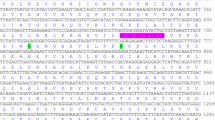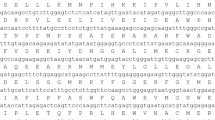Abstract
Glutathione transferases (GSTs; EC 2.5.1.18) play important roles in stress tolerance and metabolic detoxification in plants. In higher plants, studies on GSTs have focussed largely on agricultural plants. There is restricted information about molecular characterization of GSTs in gymnosperms. To date, only tau class GST enzymes have been characterized from some pinus species. For the first time, the present study reports cloning and molecular characterization of two zeta class GST genes, namely PbGSTZ1 and PbGSTZ2 from Pinus brutia Ten., which is an economically important pine native to the eastern Mediterranean region and have to cope with several environmental stress conditions. The PbGSTZ1 gene was isolated from cDNA, whereas PbGSTZ2 was isolated from genomic DNA. Sequence analysis of PbGSTZ1 and PbGSTZ2 revealed the presence of an open reading frame of 226 amino acids with typical consensus sequences of the zeta class plant GSTs. Protein and secondary structure prediction analysis of two zeta class PbGSTZs have shared common features of other plant zeta class GSTs. Genomic clone, PbGSTZ2 gene, is unexpectedly intronless. Extensive sequence analysis of PbGSTZ2, with cDNA clone, PbGSTZ1, revealed 87% identity at nucleotide and 81% identity at amino acid levels with 41 amino acids differences suggesting that genomic PbGSTZ2 gene might be an allelic or a paralogue version of PbGSTZ1.






Similar content being viewed by others
References
Barling D. R., Radzio U., Steiner U. and Weiler E. W. 1993 A glutathione S-transferase with glutathione peroxidase activity from Arabidopsis thaliana. Eur. J. Biochem. 216, 579–586.
Basantini M. and Srivastava A. 2007 Plant glutathione transferases—a decade falls short. Can. J. Bot. 85, 443–456.
Board P. G., Baker R. T., Chelvanayagam G. and Jermiin L. S 1997 Zeta, a novel class of glutathione transferases in a range of species from plants to humans. Biochem. J. 238, 929–935.
Chelvanayagam G., Wilce M. C. J., Parker M. W., Tan K. L. and Board P. G 1997 Homology model for the human GSTT2 theta class glutathione transferase. Proteins 27, 118–130.
Cummins I., Cole D. J. and Edwards R. A. 1998 Role for glutathione S-transferases functioning as glutathione peroxidases in resistance to multiple herbicides in black-grass. Plant J. 18, 285–292.
Diopan V., Shestivska V., Zitka O., Galiova M., Adam V., Kaiser J. et al. 2010 Determination of plant thiols by liquid chromatography coupled with coulometric and amperometric detection in lettuce treated by lead(ii) ions. Electroanalysis 22, 1248–1259.
Dixon D. P., Cole D. J. and Edwards R. 2000 Characteristics of a zeta class GSTs from Arabidopsis thaliana with a putative role in tyrosine catabolism. Arch. Biochem. Biophys. 384, 407–412.
Dixon D. P., Lapthorn A. and Edwards R. 2002 Plant glutathione transferases. Genome Biol. 3. REVIEWS3004.
Edwards R. and Dixon D. P. 2000 The role of glutathione transferases in herbicide metabolism. In Herbicides and their mechanisms of action, pp. 33–71. Sheffield Academic Press, Sheffield, UK.
Edwards R. and Dixon D. P. 2005 Plant glutathione transferases. Methods Enzymol. 401, 169–186.
Frova C. 2003 The plant glutathione transferase gene family: genomic structure, functions, expression and evolution. Physiol. Plant 119, 469–479.
Hall T. A. 1999 BioEdit: a user-friendly biological sequence alignment editor and analysis program for Windows95/98/NT. Nucleic Acids Symposium Ser. 41, 95–98.
Itzhaki H. and Woodson W. R. 1993 Characterization of an ethylene-responsive glutathione S-transferase gene cluster in carnation. Plant Mol. Biol. 22, 43–58.
Kampranis S. C., Damianova R., Atallah M., Toby G., Kondi G., Tsichlis P. N. and Makris A. M. 2000 A novel plant glutathione S-transferase/peroxidase suppresses Bax lethality in yeast . J. Biol. Chem. 275, 29207–29216.
Kang G. Z., Li G. Z., Liu G. Q., Xu W., Peng X. Q., Wang C. Y. et al. 2013 Exogenous salicylic acid enhances wheat drought tolerance by influence on the expression of genes related to ascorbate–glutathione cycle. Biol. Plant 57, 718–724.
McGonigle B., Keeler S. J., Lau S. M, Koeppe M. K and O’Keefe D. P. 2000 A genomic approach to the comprehensive analysis of the glutathione S-transferase gene family in soybean and maize. Plant Physiol. 124, 1105–1120.
Meyer Jr R. C., Goldsbrough P. B. and Woodson W. R. 1991 An ethylene-responsive gene from carnation encodes a protein homologous to glutathione S-transferases. Plant Mol. Biol. 17, 277–281.
Mueller L. A., Goodman C. D., Silady R. A. and Walbot V. 2000 AN9, a petunia glutathione S-transferase required for anthocyanin sequestration, is a flavonoid-binding protein. Plant Physiol. 123, 1561–1570.
Naliwajski M. R. and Sklodowska M 2014 The oxidative stress and antioxidant systems in cucumber cells during acclimation to salinity. Biol. Plant 58, 47–54.
Oztetik E. 2008 Tale of plant glutathione S-transferases: since 1970. Bot. Rev. 74, 419–437.
Rennenberg H. 1982 Glutathione metabolism and possible biological roles in higher plants. Phytochemistry 21, 2771–2781.
Ridnour L. A., Winters R. A. and Spitz D. R. 1999 Measurement of glutathione, glutathione disulfide and other thiols in mammalian cell and tissue homogenates using high-performance liquid chromatography separation of N-(1-pyrenyl) maleimide derivatives. Methods Enzymol. 299, 258–267.
Roxas V. P., Smith Jr R. K., Allen E. R and Allen R. D. 1997 Overexpression of glutathione S-transferase/glutathione peroxidase enhances the growth of transgenic tobacco seedlings during stress. Nat. Biotechnol. 15, 988–991.
Sheehan D., Meade G., Foley V. and Dowd C. A. 2001 Structure, function and evolution of glutathione transferases: implications for classification of non-mammalian members of an ancient enzyme superfamily. Biochem. J. 360, 1–16.
Smith I. K., Polle A. and Rennenberg H. 1990 Glutathione. In Stress responses in plants: adaptation acclimation mechanisms. (ed. R. G. Alscher and J. R. Cumming). pp. 201–215. Wiley, New York, USA.
Soranzo N., Sari Gola M., Mizzi L., De Toma G. and Frova C. 2004 Organisation and structural evolution of the rice glutathione S-transferase gene family. Mol. Genet. Genomics 271, 511–521.
Subramaniam K., Ye Z., Buechley G., Shaner G., Solomos T. and Ueng P. P. 1999 Isolation of a zeta class wheat glutathione S-transferase gene. Biochim. Biophys. Acta 1447, 348–356.
Thom R., Dixon D. P., Edwards R., Cole D. J. and Lapthorn A. 2001 The structure of a zeta class glutathione S-transferase from A. thaliana: characterization of a GST with novel active site architecture and a putative role in tyrosine catabolism. J. Mol. Biol. 308, 949–962.
Tsuchiya T., Takesawa T., Kanzaki H. and Nakamura I. 2004 Genomic structure and differential expression of two tandem-arranged GSTZ genes in rice. Gene 335, 141–149.
Wagner U., Edwards R., Dixon D. P. and Mauch F. 2002 Probing the diversity of the Arabidopsis GST gene family. Plant Mol. Biol. 49, 515–532.
Wang Z. Y., Song F. B., Cai H., Zhu M. Y., Bai X. and Ji W. 2012 Over-expressing GsGST14 from Glycine soja enhances alkaline tolerance of transgenic Medicago sativa. Biol. Plant 56, 516– 520.
Zeng Q. Y. and Wang X. R. 2006 Divergence in structure and function of tau class glutathione transferase from Pinus tabulaeformis, P. yunnanensis and P. densata. Biochem. Syst. Ecol. 34, 678–690.
Acknowledgements
Thanks to Prof. Heinz Rennenberg and Dr Stanislav Kopriva from Forest Botanic and Tree Physiology Institute, Albert-Ludwigs University, Freiburg, Germany, for providing the initial EST sequences and their help in Northern blot and glutathione assays. Dr Elif Oztetik was supported by Tubitak short term fellowship. This work was financially supported by University of Anadolu Reseach Project.
Author information
Authors and Affiliations
Corresponding author
Additional information
[Oztetik E., Kockar F., Alper M. and Iscan M. 2015 Molecular characterization of zeta class glutathione S-transferases from Pinus brutia Ten. J. Genet. 94, xx–xx]
Rights and permissions
About this article
Cite this article
OZTETIK, E., KOCKAR, F., ALPER, M. et al. Molecular characterization of zeta class glutathione S-transferases from Pinus brutia Ten.. J Genet 94, 417–423 (2015). https://doi.org/10.1007/s12041-015-0538-5
Received:
Accepted:
Published:
Issue Date:
DOI: https://doi.org/10.1007/s12041-015-0538-5




